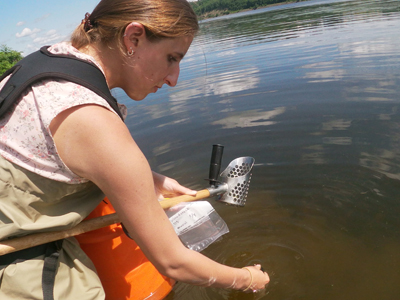Environmental science student researching microplastic content of Saint John River freshwater mussels
 Mount Allison environmental science student Casey Doucet is doing research in a new and environmentally important field, the study of microplastics.
Mount Allison environmental science student Casey Doucet is doing research in a new and environmentally important field, the study of microplastics.
Doucet, who is from Pictou County, Nova Scotia is looking at the microplastic content of freshwater mussels in the Saint John River and its tributaries. She received a Mount Allison Student Summer Research grant to carry out her work this summer.
“We are looking at their exposure to microplastics and I will try and determine what their microplastic content is,” she says.
Doucet is also looking at wastewater treatment plants and whether mussels downstream of these plants have different exposure levels.
“We know that the treatment plants are a major contributor of microplastics. We want to see the spatial distribution of microplastics in the watershed as well,” says Doucet.
Doucet’s project is part of a larger study at Mount Allison, Emerging concerns of microplastic pollution in the Saint John River watershed, that received over $184,000 in funding from Environment and Climate Change Canada (ECCC) through the Atlantic Ecosystems Initiatives program.
“As part of a research team, Casey contributes to many aspects of our project—from study design to logistics to lab procedures to data synthesis and then communication of results. This level of participation results in a high-quality learning experience,” says Geography and Environment professor, Dr. Joshua Kurek who is one of the lead researchers awarded the funding.
Doucet says other studies have already shown that mussels will take up microplastics, and because of this they were expecting to find them. What they want to know is just how much is being taken up.
“We’re more interested in seeing to what extent they are being acquired by mussels in this watershed and if the mussels could be a potential pathway for microplastics to enter the aquatic food web,” she says.
“Consequently, if there were microplastics in the mussels, and muskrats are eating them, they too are taking up the microplastics as well.”
Doucet, who is also minoring in biology, geography, and fine arts, chose to study environmental science because she had always been fascinated by nature.
“I also wanted to pursue something that I felt was meaningful,” says Doucet. “Entering a field that pertains to protecting the environment seemed like an obvious choice.”
She chose Mount Allison because as well as her concern for the environment she loves drawing and was unsure in high school whether to pursue science or fine arts.
“Mount A allowed me to do both rather than choose,” she says.
Next year, Doucet plans to continue her studies by doing a Master’s degree an environmental research.




